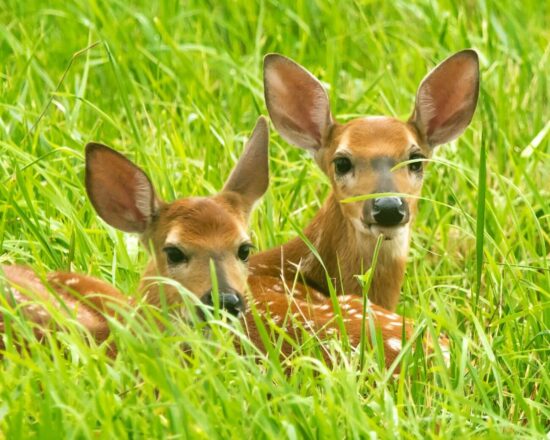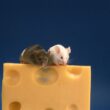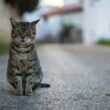What would you say if we told you a deer could have a belly full of hay, but slowly be starving? This isn’t made up. It actually happens when people try to help deer by feeding them hay during tough winters.
So do deer eat hay? The answer is more complicated than you might think.
What Makes Deer Different from Cows and Horses
Deer aren’t like farm animals when it comes to eating. While cows can munch on grass all day and stay healthy, deer are what scientists call “concentrate selectors.” This fancy term means deer need foods that are packed with nutrients and easy to digest quickly.
Their anatomy, behavior, and physiology are adapted to selection of specific types of forage that differ from other potential forage competitors like cattle, elk, and moose. Deer have smaller stomachs compared to their body size, so they can’t hold as much food. This means every bite needs to count nutritionally.
Think of deer as picky eaters who need the good stuff. They use their narrow snouts and long tongues to carefully pick the most nutritious parts of plants. Meanwhile, cows are more like vacuum cleaners, eating everything in their path.
How Deer Digestion Really Works
Here’s where things get interesting. Deer have four-chambered stomachs, just like cows, but theirs work differently. The magic happens thanks to tiny bacteria living in their stomachs. These bacteria break down plant material and create nutrients that deer can absorb.
A deer has to eat a new food for one to two weeks before it can start pulling nutrients from that food. This is because it takes time for the micro-flora – the bacteria that live in the deer’s gut and help with digestion – to adjust and become capable of dealing with the new food source.
The bacteria change with the seasons too. In summer, deer have more bacteria that handle leaves and soft plants. In winter, different bacteria take over to help digest woody twigs and bark. This seasonal switch is crucial for understanding why deer eating hay can be dangerous at certain times of year.
What Deer Actually Want to Eat
Deer eating hay isn’t their first choice. In fact, it’s pretty far down their list of preferred foods. Here’s what deer really want:
Browse makes up the biggest part of their diet. Browse (leafy parts of woody plants) and forbs provide over 80% of the diet in all seasons except during autumn. This includes leaves, twigs, and buds from trees and shrubs.
Forbs are basically weeds to humans but candy to deer. These broad-leafed plants like wildflowers and herbs are loaded with protein and easy to digest. Forbs are typically lower in fiber and higher in digestible protein than other forage classes.
Mast includes nuts, acorns, and berries. Mast consumption increases from 11% during summer (primarily soft mast, such as berries) up to 28% during autumn (primarily hard mast, such as acorns).
Grass makes up less than 10% of what deer eat, and that’s usually only when it’s young and tender in spring. Grasses comprise only a very small part of the overall diet of the white-tailed deer. Often, it’s less than 10 percent.
When Deer Might Actually Eat Hay
So when do deer eat hay? It depends on the season, the situation, and what other food is available.
Summer feeding works better because deer have the right bacteria in their stomachs to handle different foods. During the start of favorable seasons, when winter is long gone, the deer can be seen actively eating hays and grains without much trouble. But even then, they’re not eating hay alone. They’re mixing it with their usual diet of browse and forbs.
Northern climates see more deer eating hay successfully. In places like Canada, where winters are harsh and food is scarce, deer will readily eat alfalfa bales. The cold climate and lack of other options make hay more acceptable.
Gradual introduction is key. If the deer have long been introduced to eating hay alongside their preferred diet of forbs, then this poses no major problem. This is because, over time, they would have built up microflora in their stomach necessary for the digestion and degradation of the hay.
The Dangerous Side of Deer Eating Hay
Here’s where the story gets serious. Well-meaning people trying to help deer can actually make things worse. There’s a heartbreaking example from Oregon where wildlife officials fed tons of hay to trapped deer. The herd of deer did eat the alfalfa hay that were supplied for them, only to die later on from starvation with hay-filled bellies.
Winter feeding dangers are real. The worst thing we can do for deer in a tough winter is shock their system by providing a new food, particularly a high-energy food such as corn or high-protein food such as alfalfa hay that they are not used to. Their digestive systems have already adapted for winter browse, and sudden changes can kill them.
The timing problem creates life-threatening situations. Deer may feed on hay during the harsh winter seasons and react negatively to them. Apparently, they do not have the bacteria in their digestive system to degrade these days.
Different hay types pose different risks. Grass hay is particularly bad because deer can’t digest grass efficiently. Alfalfa hay is better but can cause bloating if deer eat too much too quickly.
What Science Says About Feeding Deer Hay
Research from multiple universities shows that feeding deer isn’t as helpful as people think. Research at the University of New Hampshire showed that a healthy deer begins winter with a 90-day fat supply. Deer are naturally adapted to survive winter on their stored fat and whatever woody browse they can find.
Wildlife biologists consistently recommend against supplemental feeding. Supplemental winter feeding of white-tailed deer offers no benefit to the size or health of deer herds on the landscape scale. Research has shown this to be true across the northern tier of states from Maine to Montana.
The Penn State Deer Management Center does feed captive deer a daily diet that includes alfalfa hay, but these are controlled conditions with gradual diet introduction and veterinary oversight. Sudden changes in diet can cause severe health problems for whitetail deer.
Why Natural Food is Better
Instead of wondering “do deer eat hay,” landowners should focus on providing natural food sources. Deer eating hay isn’t natural behavior, and it can create dependency and health problems.
Habitat management works better than feeding. Cutting brush and small trees puts fresh browse within reach of deer. This gives them the woody material their winter digestive systems are designed to handle.
Native plants provide year-round nutrition. Creating areas with diverse forbs and browse plants gives deer what they actually want to eat. These plants also support other wildlife and don’t require constant maintenance.
Food plots can work if they focus on natural deer preferences. Instead of hay, plant native forbs, legumes, and browse species that deer would naturally encounter.
The Real Cost of Feeding Hay
Deer eating hay creates problems beyond just digestive issues. Artificial feeding makes deer abnormally competitive. Competition between deer in natural situations usually is limited, because natural food sources are scattered.
Disease spread increases when deer crowd around feeding stations. When deer are abnormally close to one another, contagious diseases or parasites are more easily spread.
Behavioral changes can be permanent. Deer lose their natural fear of humans and may become aggressive or dependent on artificial food sources.
Legal issues exist in many states. Some places have made feeding deer illegal because of the problems it causes.
What to Do Instead
If seeing deer struggle in winter is hard to watch, there are better ways to help than putting out hay bales.
Create winter cover by leaving brush piles and dense vegetation where deer can shelter from wind and snow.
Manage your land for natural deer food. Plant native shrubs and trees that provide browse. Maintain openings where forbs can grow.
Contact professionals if deer seem to be in real trouble. Wildlife biologists can assess the situation and recommend appropriate action.
Let nature work as hard as it sounds. Severe winters will kill deer and there is nothing that can be done about it. This is true for many species of wildlife. That is the way of nature.
Common Mistakes People Make
Many folks think deer eating hay is just like feeding horses or cows. But deer have very different needs and digestive systems. Here are the biggest mistakes:
Putting out hay during winter when deer can’t digest it properly. Their gut bacteria have already switched to winter mode.
Thinking all hay is the same. Grass hay is worse for deer than alfalfa, but both can cause problems if introduced suddenly.
Feeding only hay without other food sources. Even when deer can digest hay, they need variety in their diet.
Starting emergency feeding without continuing it all winter. Once deer depend on artificial food, stopping can kill them.
The Bottom Line
So, do deer eat hay? Yes, under certain conditions. But should you feed hay to deer? Probably not. Deer eating hay can lead to serious health problems, especially during winter when their digestive systems are adapted for woody browse.
The best way to help deer is to provide natural habitat and let them eat what they’re designed to eat. If you’re concerned about deer on your property, contact your local wildlife agency for advice. They can help you make decisions that truly benefit deer rather than putting them at risk.
Remember, deer have survived for thousands of years without hay bales. Their bodies know how to handle natural food sources and seasonal changes. Sometimes the kindest thing we can do is let wild animals be wild.


